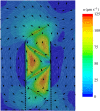Hydrodynamics of the leucon sponge pump
- PMID: 30958143
- PMCID: PMC6364629
- DOI: 10.1098/rsif.2018.0630
Hydrodynamics of the leucon sponge pump
Abstract
Leuconoid sponges are filter-feeders with a complex system of branching inhalant and exhalant canals leading to and from the close-packed choanocyte chambers. Each of these choanocyte chambers holds many choanocytes that act as pumping units delivering the relatively high pressure rise needed to overcome the system pressure losses in canals and constrictions. Here, we test the hypothesis that, in order to deliver the high pressures observed, each choanocyte operates as a leaky, positive displacement-type pump owing to the interaction between its beating flagellar vane and the collar, open at the base for inflow but sealed above. The leaking backflow is caused by small gaps between the vaned flagellum and the collar. The choanocyte pumps act in parallel, each delivering the same high pressure, because low-pressure and high-pressure zones in the choanocyte chamber are separated by a seal (secondary reticulum). A simple analytical model is derived for the pump characteristic, and by imposing an estimated system characteristic we obtain the back-pressure characteristic that shows good agreement with available experimental data. Computational fluid dynamics is used to verify a simple model for the dependence of leak flow through gaps in a conceptual collar-vane-flagellum system and then applied to models of a choanocyte tailored to the parameters of the freshwater demosponge Spongilla lacustris to study its flows in detail. It is found that both the impermeable glycocalyx mesh covering the upper part of the collar and the secondary reticulum are indispensable features for the choanocyte pump to deliver the observed high pressures. Finally, the mechanical pump power expended by the beating flagellum is compared with the useful (reversible) pumping power received by the water flow to arrive at a typical mechanical pump efficiency of about 70%.
Keywords: choanocytes; computational fluid dynamics; flagellar vane; low Reynolds number flow; positive displacement pump.
Conflict of interest statement
We declare we have no competing interests.
Figures







References
-
- Jørgensen CB. 1966. Biology of suspension feeding. Oxford, UK: Pergamon Press.
-
- Riisgård HU, Kumala L, Charitonidou K. 2016. Using the F/R-ratio for an evaluation of the ability of the demosponge Halichondria panicea to nourish solely on phytoplankton versus free-living bacteria in the sea. Mar. Biol. Res. 12, 907–916. ( 10.1080/17451000.2016.1206941) - DOI
-
- Reiswig HM. 1971. In situ pumping activities of tropical demospongiae. Mar. Biol. 9, 38–50. ( 10.1007/BF00348816) - DOI
Publication types
MeSH terms
LinkOut - more resources
Full Text Sources

